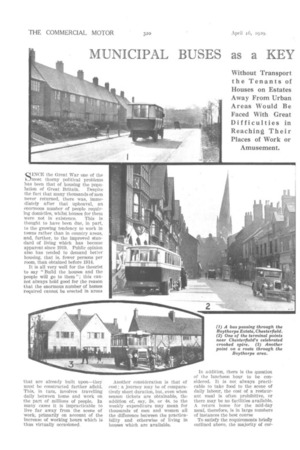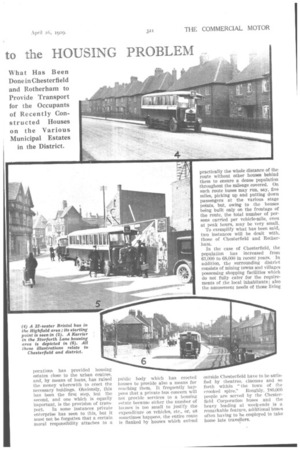MUNICIPA USES as a KEY
Page 114

Page 115

Page 116

If you've noticed an error in this article please click here to report it so we can fix it.
to the HOUSING PROBLEM
SINCE the Great War one of the most thorny political problems has been that of housing the popu
lation of Great Britain. Despite the fact that many thousands of men never returned, there was, immediately after that upheaval, an enormous number of people requiring domiciles, whilst houses for them were not in existence. This is thought to have been due, in part, to the growing tendency to work in towns rather than in country areas, and, further, to the improved standard of living which has become apparent since 1919. Public opinion also has tended to demand better housing, that is, fewer persons per room, than obtained before 1914.
It is all very well for the theorist to say "Build the houses and the people will go to them "; this cannot always hold good for the reason that the enormous number of homes required cannot be erected in areas that are already built upon—they must be constructed farther afield. This, in turn, involves travelling daily between home and work on the part of millions of people. In many cases it is impracticable to live far away from the scene of -work, primarily on account of the increase of working hours which is thus virtually occasioned.
Another consideration is that of cost ; a journey may he of comparatively short duration, but, even when season tickets are obtainable, the addition of, say, as. or 4s. to the weekly expenditure may mean for thousands of men and women all the difference between the practicability and otherwise of living in houses which are available. In addition, there is the question of the luncheon hour to be considered. It is not always practicable to take food to the scene of daily labour, the cost of a restaurant meal is often prohibitive, or there may be no facilities available. A return home for the mid-day meal, therefore, is in large numbers of instances the best course To satisfy the requirements briefly outlined above, the majority of cor pc/rations has provided housing estates close to the urban centres, and, by means of loans, has raised the money wherewith to erect the necessary buidings. Obviously, this has been the first step, but the second, and one which is equally important, is the provision of trans port. In some instances private enterprise has seen to this, but it must not be forgotten that a certain moral responsibility attaches to a public body which has erected houses to provide also a means for reaching them. It frequently happens that a private bus concern will not provide services to a housing estate because either the number of hoases is too small to justify the expenditure on vehicles, etc., or, as sometimes happens, the entire route is flanked by houses which extend practically the whole distance of the route without other houses behind them to ensure a dense population throughout the mileage covered. On such route buses may run, say, five miles, picking up and putting down passengers at the various stage points, but, owing to the houses being built only on the frontage of the route, the total number of persons carried per vehicle-mile, even at peak hours, may be very small.
To exemplify what has been said, two instances will be dealt with, those of Chesterfield and Rotherham.
In the case of Chesterfield, the population has increased from 61,000 to 68,000 in recent years. In addition, the surrounding district consists of mining towns and villages possessing shopping facilities which do not fully cater for the requirements of the local inhabitants; also the amusement needs of those living outside Chesterfield have to be satisfied by theatres, cinemas and so forth within " the town of the crooked spire." Roughly, 180,000 people are served by the Chesterfield Corporation buses and the heavy loading at week-ends is a remarkable feature, additional buses often having to be employed to take home late travellers. Some 1,100 houses have been built on three estates in and around Chesterfield. Out of the 15 routes operated by the Corporation tramways department, of which the general manager is Mr. R. Hoggard, M.In.st.T„ five routes run to these three housing estates, and the fleet of 66 vehicles carried in 1928 some two million passengers, one-and-ahalf million on buses and half-amillion on trackless vehicles. The petrol buses are of Bristol and Karrier makes and have to cover exceedingly hilly and tortuous roads on the routes leading out of the town. Despite this, a good average speed is maintained, the service intervals being from half-an-hour to six minutes, according to the time of day.
It is possible for many of the workers in Chesterfield to get home for the midday meal and back again in time for the resumption of work, as the length of route from the terminal point in town to that on any of the housing estates is not more than 24 miles, the greatest fare being 3d. single and 44d. for the return ticket. Naturally, more vehicles are put into service in the morning and evening than during the intervening period, but the service is amplified at lunch time to enable those to get home who wish to ado so.
Passengers for places farther afield are also catered for in that buses are available to Sheffield (12 miles away), Bolsover, Staveley, Clay Cross, Grassmoor, Wingfield, New Wittington, Newbold Spittal, Temple Normanton, and Sutton Scarsdale. The three housing estates which are specifically served are those of Highfield, St. Augustine's and Boythorpe. Rents in these districts vary from 13s. 5d. to 16s. per week inclusive of rates, approximately half of the houses being of the parlour type and half of the non-parlour type, but all have three bedrooms and a bathroom, in addition to accommodation on the ground floor. From the rents given it will be fully realized that a heavy expenditure in travelling to and from work would not be possible on the part of the tenants, and it will be plain that the municipal bus in Chesterfield and district has provided a vital link between the homes of the people and the places in which they earn their daily bread and take their amusements.
Turning now to Rotherham, we find that the population has risen from 68,000 in 1921 to 72,000 last year ; some 2,164 houses have been built by the county borough of Rotherham since 1920; 300 more will shortly be commenced. In addition, the Rotherham Rural District authority has constructed 1,600 houses, and private concerns have contributed a fair number, in addition.
Both petrol buses and railless vehicles are employed, there being 48 of the former and 15 of the latter. Amongst the routes operated in Rotherham and district, three serve the principal municipal housing estates of Canttow, Blackburn and East Dene. Guy and Bristol vehicles are employed, main
taming an average speed of 74 m.p.h.
As an indication of the numbers of passengers travelling to the housing estates it may be mentioned that one-and-a-half million passengers were conveyed last year on the five routes which serve the three areas named. The 20-seater vehicles now employed are being discarded in favour of 32-seaters, the better to cope with the increased traffic on the routes in question. The total distance of each route is approximately 14 miles, the single fare being 2d., but discount tickets are issued in bundles of 12 at the rate of 14d., thus facilitating cheap travel once or twice each way daily, as required.
During the slack hours of the day the service is a 10minute one, but at peak-load hours a 24-minute service is provide d, the 32-seater vehicles carrying on the work during the busier hours.
As an indication of the types of house provided on the various estates of the county borough of Rotherham, the exclusive rents of 7s. 6d. to 10s. 6d. a week may be mentioned. Some non parlour houses with two bedrooms can be had for so little as 5s. 6d. per week.
In addition to the buses, railless routes are operated, one of which stretches to Maltby, a distance of seven miles. On this route practically all the houses are built along the main-road frontage; consequently frequent stops are necessary and the bulk of passengers is small.
Those who have houses farther afield than the municipal estates are well provided for by the longdistance services operating under the wgis of the Rotherham Corporation Tramways Department, the general manager of which is Mr. T. P. Sykes, M.Inst.T.








































































































































































































